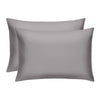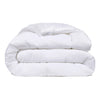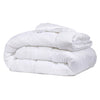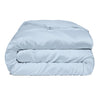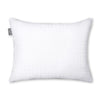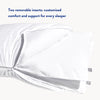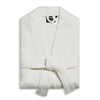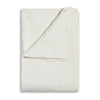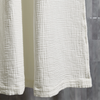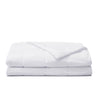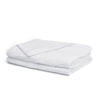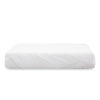The Daily Miracle
How To Wash a Duvet Cover — The Right Way!
Published
September 13, 2021
Author
Suze Dowling

When it comes to keeping your bedding spick-and-span, one of the most stressful components is figuring out how to re-insert your comforter into the duvet cover after you wash it.
And that dread can build, making you reluctant to wash your sheets — but regularly washing your sheets is so important because the dust, dirt, and (yes) microorganisms that accumulate over time can harm your health.
Not to mention, it’s just a bit gross. So let’s go over everything you need to know about how to clean duvet covers.
How To Wash a Duvet Cover
Considering we spend one-third of our life trying to sleep or sleeping, it’s important to make sure that your bed is a happy place to visit each night, and keeping everything clean and fresh is a crucial part of that equation.
We're here to provide the miracle solution you need. We have assembled a comprehensive guide on how to wash duvet covers, dry them effectively, care for them, and even prevent those pesky wrinkles so you can feel like a pro every time you make your bed.
Can You Wash a Duvet in the Washing Machine?
The answer, for most duvet covers, is a resounding yes! However, it's essential to check the manufacturer's care instructions before you toss your cover into the washer. Some delicate materials may require hand washing or professional dry cleaning.
When it comes to our duvet covers, machine washing is absolutely fine! Our superior materials can withstand the spin cycle, promising you a clean, fresh duvet cover without any laundry-induced stress.
Can You Wash a Duvet Cover With the Duvet Inside?
You may ask yourself, “can you wash a duvet cover with the duvet inside?”No, the duvet insert or down comforter should be removed from the cover before washing. Washing duvets together could lead to uneven cleaning, and the heavy, soaked insert might damage your washing machine. Plus, if it’s not made with a down alternative, your comforter might have more finicky care needs and be better off with a spot cleaning.
But don’t worry, washing your Miracle Made® Comforter doesn’t have to add hassle to your day. It’s easy to clean, and its composition helps keep you at the perfect temperature all night long. It helps prevent 99.7% of bacteria growth, so you don’t have to do laundry as much. Up to 3x less than usual, in fact!
So, how exactly do you go about duvet washing?
Instructions for Duvet Washing
Getting ready for a duvet wash? Follow these steps for a flawless, stress-free process to wash a duvet.
- Removing the duvet insert: Start by taking out the duvet insert. With the cover empty, it's ready for a thorough, even duvet wash.
- Choosing the right detergent: It's crucial to choose a gentle detergent that won't harm the fabric. Avoid bleach and fabric softener, which could deteriorate the material over time.
- Setting the wash cycle: You should use a gentle or delicate wash cycle to wash duvet covers. When it comes to water temperature, cold water is your best bet to prevent shrinkage and color fading. However, if you're dealing with stubborn stains or need a deep clean, warm water can be used sparingly.
If you’re washing a duvet insert as well, be sure to check the care instructions first to ensure it’s machine washable. And if you can put it on the dryer, ensure it dries completely before inserting it back into your duvet cover to avoid mildew.
Adding tennis balls or dry towels to the dryer with your duvet can also help absorb excess moisture and allow it to dry more efficiently!
How Often Should You Wash Your Duvet Cover?
The frequency of duvet washing depends on several factors, including personal habits, allergies, and more. However, as a general rule, you should wash a duvet cover every two weeks.
If you use a top sheet, you can probably stand to go a little longer because there’s a barrier between you and the duvet cover while you sleep. But if you sleep without one, you’ll want to err on the more frequent end of this spectrum.
Our comforters, duvet covers, and even our sheet sets require less frequent washes than other brands, thanks to their antibacterial features, so if you’re looking for a way to simplify your spring cleaning…this is your sign to make the change!
Can I Put the Duvet Cover in the Dryer?
So, can you use the dryer after washing a duvet? The good news is, you usually can, but there's a catch.
Before you toss your duvet cover into the dryer, it's essential to check the manufacturer's care instructions. Every fabric behaves differently under high heat; the last thing you want is a shrunken duvet cover!
Instructions for Drying Your Duvet Cover
Air-drying is the safest and most gentle way to dry your duvet cover. Just hang it on a clothesline and let the warm breeze do its job. This method is good for the fabric, energy-efficient, and environmentally friendly.
If time is of the essence, you can also use a dryer, though be sure to adjust the heat setting to low. High heat can damage the fabric, causing it to shrink or lose its softness. To avoid this, use the tumble dry or low heat setting.
To make the drying process even more efficient after washing a duvet cover, try tossing in a couple of wool dryer balls. They'll help fluff up your duvet cover and reduce the drying time. Plus, they can also help minimize tangling during the drying process.
How To Prevent My Duvet from Getting Wrinkles
Wrinkles can be a real dampener when trying to achieve that crisp, hotel-quality look with your bed linens — especially after washing a duvet. Remove your duvet cover from the dryer while it's still slightly damp to prevent wrinkles after washing the duvets. Lay it flat or immediately, or hang it over a clothesline so it’s completely extended.
How To Put a Comforter in a Duvet Cover
Fitting a comforter into a duvet cover might seem like a two-person job, but it doesn't have to be! If you’re looking for the best way to put a duvet cover on; have no fear.
- Turn your duvet cover inside out and lay it flat on your bed, with the opening at the foot of the bed.
- Lay your comforter or duvet insert on top.
- Starting at the head of the bed, roll the duvet cover and comforter together towards the foot of the bed — like a burrito!
- Once rolled, invert the duvet cover around the ends of the burrito and unroll it back up towards the head of the bed.
Regularly Washing a Duvet Can Keep It Fresh for Life
Clean bed linens are not just about appearances; they also reduce the spread of dust mites and other allergens, providing you with a better night's sleep. Miracle Brand's duvet covers, crafted from high-quality, eucalyptus-based sheets, add another layer of benefits. The silver-infused fabric is antibacterial, reducing the need for frequent washing and making them perfect for people with sensitive skin or allergies.
Following these duvet washing, drying, and maintenance instructions will keep your duvet cover and, in turn, your sleeping environment in optimal condition. Embrace these tips and enjoy the feeling of sliding into clean, comfortable bed linens every night.
Sources:
- Laundry and Textile Hygiene in Healthcare and Beyond | National Library of Medicine
- We Spend About One-Third of Our Life Either Sleeping or Attempting to Do So | National Library of Medicine
- Antimicrobial Silver in Medicinal and Consumer Applications: A Patent Review of the Past Decade | National Library of Medicine
- How Often Should You Wash Your Sheets | Sleep Foundation


